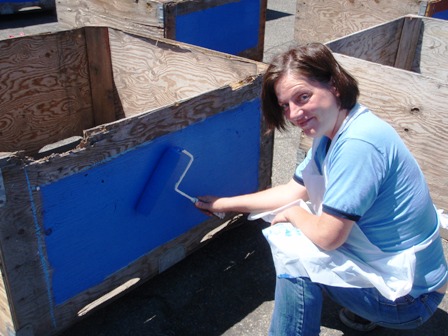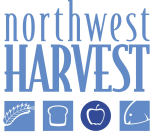Northwest Harvest’s Culls for Community program utilizes commercial growers’ existing disposal systems to recover edible but unmarketable produce (culls) in large quantities. Commercial farms typically sort produce in the field or in the packing shed to avoid accruing costs by shipping unmarketable produce to their buyers. The Culls for Community program captures these culls with specially-marked bins for hunger relief.
Compared to field gleaning, this program requires little to no effort in the field but requires trucking and transportation systems as well as a steady stream of volunteers in the warehouse to sort and re-pack produce. Additionally, cold storage is extremely helpful for this type of program, since produce can sit in bins in cold storage until volunteers are available to sort it. This program has been very successful with large and mid-sized, diverse vegetable farms in the Yakima Valley. It would also be appropriate for hard fruits but would be more difficult with soft fruits. Soft fruits like peaches, apricots, and cherries do not stand up well to lots of handling and are much more perishable, so they require a soft touch and immediate attention in the warehouse.
For a typical month during harvest season, here is an example of the materials and time required for the program:
Grower A: 20-25bins. Pick up 6 bins twice per week and drop off the same number each trip.
Grower B: 20-25 bins. Pick up 2-6 bins once per week and drop off the same number each trip.
 The number of bins takes into account picking up and dropping off bins while some wait in cold storage to be sorted by volunteers. In August 2012, the Culls for Community program in Yakima conservatively received 70-80,000lbs of produce from these two Culls for Community donors. This produce took roughly 475 volunteer hours to re-pack produce into boxes. For transportation, one staff member drove one truck which fits 6 pallets or bins out to the farms and back to the warehouse.
The number of bins takes into account picking up and dropping off bins while some wait in cold storage to be sorted by volunteers. In August 2012, the Culls for Community program in Yakima conservatively received 70-80,000lbs of produce from these two Culls for Community donors. This produce took roughly 475 volunteer hours to re-pack produce into boxes. For transportation, one staff member drove one truck which fits 6 pallets or bins out to the farms and back to the warehouse.
If bins are donated and not borrowed, it is beneficial to re-paint them a bright color and mark them with the name or logo of the hunger relief program. Re-painting tells the packing house workers which bins are for donations and which are for trash. Before the Yakima program used painted bins for Grower A, workers were throwing trash (lunches, wrappers, etc.) into the bins, and warehouse volunteers had to sort through the trash when re-packing produce. Having painted bins also helps the warehouse workers easily distinguish donation bins when the Northwest Harvest driver arrives and keeps the bins from wandering away.

 The number of bins takes into account picking up and dropping off bins while some wait in cold storage to be sorted by volunteers. In August 2012, the Culls for Community program in Yakima conservatively received 70-80,000lbs of produce from these two Culls for Community donors. This produce took roughly 475 volunteer hours to re-pack produce into boxes. For transportation, one staff member drove one truck which fits 6 pallets or bins out to the farms and back to the warehouse.
The number of bins takes into account picking up and dropping off bins while some wait in cold storage to be sorted by volunteers. In August 2012, the Culls for Community program in Yakima conservatively received 70-80,000lbs of produce from these two Culls for Community donors. This produce took roughly 475 volunteer hours to re-pack produce into boxes. For transportation, one staff member drove one truck which fits 6 pallets or bins out to the farms and back to the warehouse.